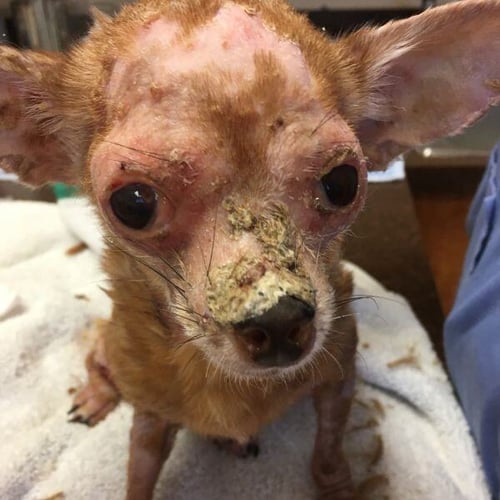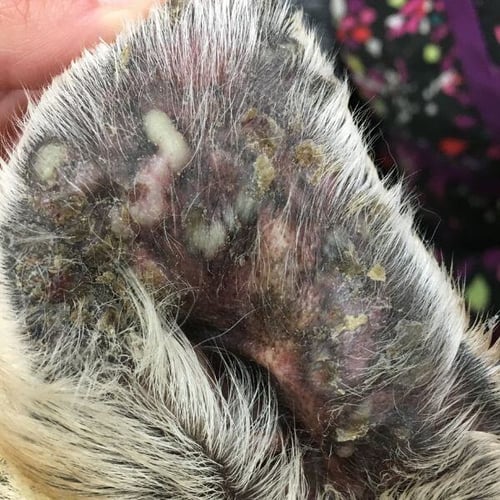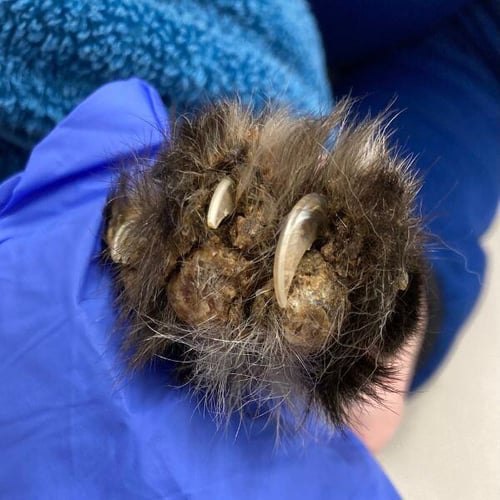 Have you been finding brown crusts on your dog or cat’s skin, or maybe redness and gunk around your cat’s claws?
Have you been finding brown crusts on your dog or cat’s skin, or maybe redness and gunk around your cat’s claws?
You’ve gone to your veterinarian, they’ve run some tests, and your pet has been diagnosed with a disease you’ve never heard of: pemphigus foliaceus.
Don’t worry! We're here to help!
It's a treatable disease, but lifelong management is required.
There are also ways to make your pet more comfortable as they recover from this uncomfortable condition.
Key Takeaways (TL/DR)
1. If Your Pet Is Diagnosed with Pemphigus Foliaceus: Your pet has an autoimmune disease. This often makes them crusty, sometimes tired and feverish, and sometimes painful on their feet, especially for cats. Read more about what this condition is
2. Pemphigus Foliaceus Is Not Contagious: Even though it's not contagious, we may not know exactly why it developed in your pet. Find out more about what causes this condition
3. Don't Panic: This is a very treatable disease in nearly all dogs and cats, even if it can't be cured. Learn about treatments
4. You Can Help Your Pet Feel Comfortable: Your veterinarian will work with you to treat this disease and get your pet as comfortable as possible, but your pet will likely need medication and regular blood test monitoring for life to control their condition. Read about how to keep your pet more comfortable
What Is Pemphigus Foliaceus?
Pemphigus foliaceus, or PF, is an autoimmune disease that occurs in dogs, cats, humans, and other animals.
It is not contagious and can’t spread to you or other pets in your home.
To understand what an autoimmune disease is, we need to first understand what the immune system is supposed to do. Your immune system is designed to fight infections by sending a mix of protective cells to sites of disease in your body. In an autoimmune disease, your body turns those protective cells on itself and attacks your healthy cells like they’re invaders. The same is happening to your cat or dog.
Technically, in PF, the body’s immune system starts to attack the connectors between cells, called desmosomes, on the upper layers of the skin, called the stratum corneum. Breaking down these desmosomes causes your skin cells to separate from each other on the skin surface, eventually leading to the crusting that you usually see on your dog or cat.
What Causes Pemphigus Foliaceus?
This is not your fault! Autoimmune diseases in any species, including dogs, cats, and humans, often do not have a known cause. Pemphigus foliaceus usually occurs without an identified trigger, but some pets can develop this condition by having an allergic reaction to a medication (called a cutaneous adverse drug reaction).
Your veterinarian will be able to determine if a drug reaction is a likely cause of your pet’s disease by looking carefully at their medication history.
There is not a particular breed of dog or cat that is more likely to develop pemphigus foliaceus. It most commonly affects middle-aged pets, but this disease can occur at any age.

Source: Alexandra Gould, DVM, DACVD
What Does Pemphigus Foliaceus Look Like in My Pet?
Pemphigus foliaceus looks pretty similar in dogs and cats. Remember those crusts we keep mentioning? Even though that’s the most common sign you see, crusting is technically the second symptom.
When skin cells separate from each other, the first thing that happens is the development of pustules (basically quarter-inch or smaller bubbles of pus) on the surface of the skin. These pustules are made up of inflammatory cells and skin cells. They burst quickly and the pus inside dries to form the crusts that you see on your pet.

Source: Alexandra Gould, DVM, DACVD
Pustules and crusting commonly occur on the face and ears first, but you can also see crusts on the back, sides, and belly.
Cats, especially, will develop crusting around their nipples on their bellies, and they will also often develop redness, swelling, and pus around the base of their claws. These crusts on the body and face can be itchy, but cats are often in pain and limping on their feet when their paws are swollen.

Source: Alexandra Gould, DVM, DACVD
Dogs and cats with PF can sometimes feel quite sick because they are experiencing so much inflammation in their bodies from the disease. They can have a fever, be less interested in eating, and also have much lower energy than usual, called lethargy.
How Does a Veterinarian Diagnose Pemphigus Foliaceus?
Pemphigus foliaceus can look like several other diseases, including fungal and bacterial skin infections.
The first step is for your veterinarian to look under the microscope at samples of cells from your pet’s skin, called a cytology. This will tell them what type of inflammatory cells are present on your pet’s skin and also whether there is any infection that needs to be treated.
After a cytology is performed and no infection is found, your veterinarian will need to take biopsies. These are small samples of the skin, usually around the size of a pencil eraser, that are sent to a pathologist — a doctor who specializes in looking at biopsies. The pathologist will look at all the layers of the skin and determine for sure if your dog or cat has pemphigus foliaceus.
How Is Pemphigus Foliaceus Treated?
Your dog or cat will need to be treated by a veterinarian to help identify and then heal this disease.
Sometimes, your primary veterinarian may recommend that your pet see a specialist, a veterinary dermatologist, to treat this condition. There are multiple medications available to treat this disease in dogs and cats, and which is recommended will depend on the severity of your pet’s PF and your veterinarian’s experience with what often works best for their patients. Your veterinarian will be able to discuss treatment options with you based on medication cost, strength, and how often your pet will need to take each drug option.
Pemphigus foliaceus is very treatable in most pets, though it can take a few months for your pet’s disease to be controlled. You may need to try a few different medications with your veterinarian to find the best fit for your pet, so be patient!
The goal in treatment is that your pet will have few to no crusts and will feel like their normal selves again. Your veterinarian will check blood samples regularly to make sure your pet is healthy while taking the drugs that they need. Most of the time, you will need to treat this disease for the rest of your pet’s life because, just as with humans, most autoimmune diseases can’t be cured.
Longterm, the cost of medication depends partly on the size of your pet — larger pets will need more drugs and that is usually more expensive. However, you can expect that most common medications will cost around $50–$250 per month.
Delaying Treatment
It can be tempting to wait and see if your pet can heal on their own without treatment. We understand — lifelong medication sounds scary and expensive! However, PF usually gets worse over time if you don’t treat it, and this can make it harder to control your pet’s condition when you start medications later.
It is really much better to start treatment immediately after your pet is diagnosed to help them feel better faster and get the best control of this disease that you can.
How to Help Your Pet Feel More Comfortable
Giving your pet baths regularly can help soften any uncomfortable crusting and moisturize your pet’s dry skin. An unscented hypo-allergenic pet shampoo is a good choice, and you can bathe your pet one or two times a week if it makes them more comfortable.
This Cera-Ve lotion can also help add moisture to your pet’s dry skin and make them less itchy. You can apply it every couple days to itchy areas to help with redness and irritation.
Even though it’s tempting, it’s not a good idea to pick at crusts that are still attached to your pet’s skin. If they’re still stuck to your pet, pulling them off will hurt and it leaves an open area that can get infected more easily. If you're finding crusts and flaking in your pet’s hair, you can gently remove them during a bath when they’re soft and pliable.



